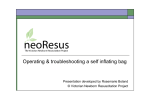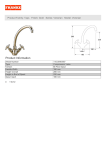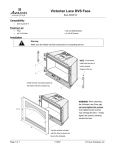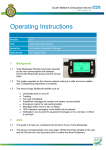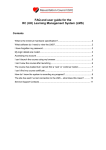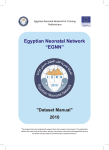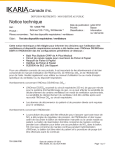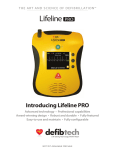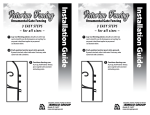Download Operating & troubleshooting a T-piece device
Transcript
Operating & troubleshooting a T-piece device: Neopuff ™ Infant Resuscitator Presentation developed by Rosemarie Boland © Victorian Newborn Resuscitation Project Aims & objectives This presentation has been designed to assist you to: Assemble the Neopuff™ T-piece device Set the recommended flow rate & pressures Operate the Neopuff™ T-piece device Troubleshoot the Neopuff™ T-piece device We suggest that you print a copy of this presentation and have the Neopuff ™ at hand to practice each action Victorian Newborn Resuscitation Project Manual ventilation devices The ARC Neonatal Guidelines state: “A self inflating bag, a flow inflating bag or a T-piece device are all acceptable devices which can be used to ventilate newborn infants either via a face mask or via an endotracheal tube”. (ARC, 2006, Guideline 13.4) Victorian Newborn Resuscitation Project T-piece device (e.g. Neopuff™ Infant Resuscitator) Advantages of using a T-piece device The operator sets the peak inspiratory pressure (PIP) & positive end expiratory pressure (PEEP) The T-piece device will not deliver PIP or PEEP/CPAP above the set pressures if the flow remains constant The PIP & PEEP are displayed on the manometer The operator can control the length of the inspiratory time by varying the duration of occlusion of the PEEP cap Victorian Newborn Resuscitation Project Positive end expiratory pressure T-piece device Can provide CPAP or PEEP Self inflating bag Does not deliver CPAP or PEEP* * Unless a PEEP valve has been fitted Why is PEEP so important? It assists with lung expansion It helps to establish functional residual capacity It leads to improved oxygenation, especially in very premature infants Victorian Newborn Resuscitation Project Setting up the Neopuff ™ To check & set the Neopuff ™ you will need: A Neopuff ™ Infant Resuscitator A compressed gas source A gas supply line (green oxygen tubing) with the plastic connector (supplied) The patient supply line (tubing & T-piece) A test lung Victorian Newborn Resuscitation Project The components of the Neopuff™ Gas supply Gas supply line Patient supply line with T-piece & mask Test lung Which gas: Air or oxygen? The ARC recommend: Use air (21%) initially If there is no improvement in condition within the first minutes of life, then introduce supplementary oxygen (ARC, 2006: Guideline 13.4) N.B: Unless an air & an oxygen cylinder (+/- a blender) is available, you will have to use 100% O2 when using the Neopuff ™ Victorian Newborn Resuscitation Project Recommended settings Gas flow rate Set at 8 L/min Maximum pressure relief valve Set at 50 cm H2O Peak inspiratory pressure (PIP) Set at 30 cm H2O Positive end expiratory pressure (PEEP) Set at 5 cm H20 (ARC, 2006: Guideline 13.4) Victorian Newborn Resuscitation Project Setting up the Neopuff:6 steps Step 1 Step 2 Step 3 • Connect the gas supply line to the gas inlet and the patient supply line to the gas outlet • Attach a test lung to the end of the patient supply line and turn the gas flow to 8 L/min • Check the maximum pressure relief is set at 50 cm H2O (adjust as necessary) Victorian Newborn Resuscitation Project Setting up the Neopuff: 6 steps Step 4 • Set the peak inspiratory pressure (PIP) to 30 cm H2O Step 5 • Set the positive end expiratory pressure (PEEP) to 5 cm H2O Step 6 • Create a good seal between the infant’s face & the face mask using the “two point top hold” Victorian Newborn Resuscitation Project 1. Connect the gas & patient supply lines 1. Connect the gas supply line via the plastic connector to the ‘gas inlet’ 2. Victorian Newborn Resuscitation Project Connect the patient supply line to the ‘gas outlet’ 2. Attach the test lung Attach the test lung to the end of the patient supply line (patient Tpiece) It is much easier to use the test lung (as opposed to a face mask or the ball of your hand) to set and test the Neopuff™ Turn the gas flow to 8 L/min Victorian Newborn Resuscitation Project 3. Check the maximum pressure has been pre-set to 50 cm H2O 1. B 2. 3. A Turn the inspiratory pressure control dial fully clockwise until it cannot turn any further (A) Occlude the PEEP cap on the patient T-piece Look at the manometer & check that the pressure gauge points to 50 cm H2O. (B) If it does, then the maximum pressure is set correctly If it is not 50 cm H2O, you will need to adjust it (See following slide) Victorian Newborn Resuscitation Project Adjusting the maximum pressure 1. 2. 3. 4. Once the inspiratory pressure control dial is fully open: Occlude the PEEP cap on the patient T-piece Open the cap covering the maximum pressure relief Turn the maximum pressure relief dial clockwise or anti-clockwise to adjust the pressure to 50 cm H2O Close the max. pressure relief cap Victorian Newborn Resuscitation Project 4. Set the peak inspiratory pressure (PIP) 1. 2. 3. Occlude the PEEP cap on the end of the patient T-piece Turn the inspiratory pressure control anti-clockwise (several times) to decrease the pressure from 50 cmH2O down to 30 cm cmH2O The set PIP is displayed on the manometer when the PEEP cap on the patient T-piece is occluded Victorian Newborn Resuscitation Project 5. Set the positive end expiratory pressure (PEEP) Set the PEEP by turning the cap on the patient T-piece clockwise or anticlockwise until a PEEP of 5 cm H2O is displayed on the manometer Caution: If the PEEP has been set on a flow rate of 8 L/min, any increase in the flow rate will result in a dangerously high increase in PEEP (Morley, Schmolzer & Davis, 2009) If you change the flow rate, then re-set and re-check the PEEP Victorian Newborn Resuscitation Project 6. Create a good seal between the infant’s face & the mask Remove the test lung & attach a face mask to the patient T-piece Position the infant’s head in a neutral position Place a finger onto the chin tip (the “guide finger”) Line up the outer edge of the mask into the groove between the guide finger and the chin tip Roll the mask onto the face from the chin upwards Victorian Newborn Resuscitation Project Holding the mask in place using the “two point top hold” Apply evenly balanced downward pressure onto the mask using the thumb and index finger positioned toward the outer edge of the flat area of the mask (“two point top hold”) Apply jaw lift with the remaining fingers so that the upward pressure works against the downward pressure from the two point top hold to create a good seal Wood, et al. (2008). Archives of Disease in Childhood, Fetal & Neonatal Edition 93, p. F231 Checking the face mask seal: “Listen & look” technique Listen for a soft whistle of gas through the PEEP cap Look that a PEEP of 5 cm H2O is displayed on the manometer 5 cm H2O Face mask leak Leaks averaging 40 to 70% around face masks are common due to poor mask placement technique & the manner in which the mask is held (see box plots) Be aware that a PIP of 30 cm H2O may be reached on the manometer despite a leak of up to 90% Wood, et al. (2008) Wood, et al. (2008) Archives of Disease in Childhood, Fetal & Neonatal Edition, 93, p. F231 Delivering positive pressure inflations with the Neopuff™ Occlude the PEEP cap using your thumb or finger for 0.5 seconds, then release for 0.5 seconds This will provide a ventilation rate of 60 inflations per minute Continue to check your mask seal by checking that the PEEP/CPAP returns to 5 cm H2O on the manometer after each manual inflation Victorian Newborn Resuscitation Project Initial inflations Higher inflation pressures (PIP > 30 cm H2O) may be needed for the initial inflations Subsequent inflations usually require less pressure, although some babies may need higher inflation pressures (higher PIP) Improvement in heart rate is the primary measure of adequate ventilation If heart rate is not improving, assess chest wall movement. Higher PIP may be required Victorian Newborn Resuscitation Project Adjusting the PIP whilst using the Neopuff Higher pressure inflations can be given by increasing the inspiratory pressure control to deliver higher PIP This can be changed while resuscitating, but requires a second person to achieve this efficiently Victorian Newborn Resuscitation Project Common problems & solutions Unable to achieve the desired PIP & PEEP when checking the Neopuff™ with the test lung Check that the gas flow rate is set to 8 L/min and that there is gas flow through the Neopuff™ circuit Still unable to achieve the desired PIP & PEEP when checking the Neopuff™ with the test lung Check the maximum pressure relief is set correctly at 50 cm H2O and adjust if necessary Victorian Newborn Resuscitation Project Common problems & solutions Unable to achieve the set PIP when ventilating the infant Check the face mask seal using the “look and listen technique” Still unable to achieve the set PIP Reposition the infant’s head and apply the face mask again Still unable to achieve the set PIP Consider intubation if mask ventilation is unsuccessful Victorian Newborn Resuscitation Project Most importantly: look at the baby, not at the manometer! Effective ventilation is confirmed by: 1. 2. An increase in the heart rate above 100 bpm A rise of the chest & upper abdomen with each inflation Achieving the set PIP on the manometer is not a sign of effective ventilation: A PIP of 30 cm H2O on the manometer can be achieved with leaks of up to 90% (Wood, et al., 2008) Victorian Newborn Resuscitation Project Remember! If the heart rate remains < 100 bpm and/or the chest is not moving despite ventilating with good technique: TURN UP THE PEAK PRESSURE (PIP) 30 → 40 → 50 → 60 cm H2O Continue to provide positive pressure ventilation until the heart rate is above 100 bpm and the infant has established effective spontaneous respirations Endotracheal intubation should be considered if ventilation via a face mask is unsuccessful Victorian Newborn Resuscitation Project References Australian Resuscitation Council (2006). Guideline 13.4: Airway management and mask ventilation of the newborn infant. Accessed December 10, 2009 from http://www.resus.org.au Fisher & Paykel Healthcare. (2004). Neopuff™ Infant Resuscitator. Optimal resuscitation in neonatal care. Auckland, New Zealand Morley, C.J., Schmolzer, G.M., & Davis, P.G. (2009). Potential hazards of the Neopuff: using appropriate gas flow. Archives of Disease in Childhood- Fetal and Neonatal Edition, 94, F467 - F468. Wood, F.E., Morley, C.J., Dawson, J.A., Kamlin, C.O., Owen, L.S., Donath, S., & Davis, P.G. (2008). Improved techniques reduce face mask leak during simulated neonatal resuscitation. Study 2. Archives of Disease in Childhood: Fetal & Neonatal Edition, 93: F230 - F234. Victorian Newborn Resuscitation Project Acknowledgements The animated graphics used in this presentation have been reproduced with the kind permission of Dr Andy Gill; Consultant Neonatologist: King Edward Memorial Hospital: Western Australia The Neopuff colour diagrams have been reproduced with the kind permission of Fisher & Paykel Healthcare: Australia and New Zealand Victorian Newborn Resuscitation Project Disclaimer This teaching program has been developed by the Newborn Emergency Transport Service (NETS) part of The Royal Women's Hospital (RWH) as an educational program around neonatal care with the assistance of a grant from the Department of Health Victoria. Whilst appreciable care has been taken in the preparation of this material, RWH shall not be held responsible for any act or omission which may result in injury or death to any baby as a result of reliance on this material. Victorian Newborn Resuscitation Project Copyright This material is copyright NeoResus: The Victorian Newborn Resuscitation Project This presentation may be downloaded for personal use but remains the intellectual property of NeoResus and as such, may not be reproduced or used for another training program without the written permission of the Victorian Newborn Resuscitation Project Executive Please contact us at [email protected] Victorian Newborn Resuscitation Project
































